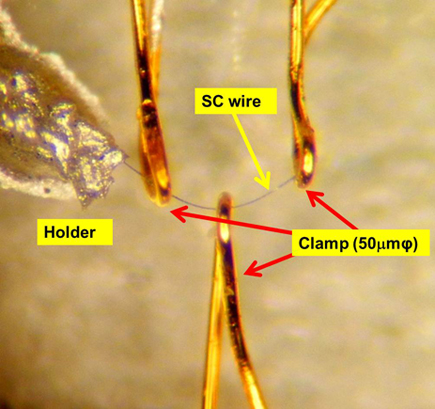Strong, Tough High Temperature Superconducting Nanowires
Success in Manufacture of Whisker Crystals of Iron-based Superconductor
2012.03.19
(2012.04.05 Update)
National Institute for Materials Science
A team headed by Dr. Kazunari Yamaura, who is a Principal Researcher in the Strongly Correlated Materials Group, Superconducting Properties Unit, National Institute for Materials Science and Jun Li, a graduate student in the NIMS Joint Graduate School Program, in joint research with NIMS Special Researcher Dr. Yuan Jie and Principal Researcher Dr. Huabing Wang, both of the Electronics Group, Superconducting Properties Unit, and Professor Hideo Hosono of the Frontier Research Center, Tokyo Institute of Technology, succeeded in the development of strong, tough high temperature superconducting nanowires.
Abstract
- A team headed by Dr. Kazunari Yamaura, who is a Principal Researcher in the Strongly Correlated Materials Group, Superconducting Properties Unit, National Institute for Materials Science (NIMS; President: Sukekatsu Ushioda) and Jun Li, a graduate student in the NIMS Joint Graduate School Program (Hokkaido University Graduate School), in joint research with NIMS Special Researcher Dr. Yuan Jie and Principal Researcher Dr. Huabing Wang, both of the Electronics Group, Superconducting Properties Unit, and Professor Hideo Hosono of the Frontier Research Center, Tokyo Institute of Technology, succeeded in the development of strong, tough high temperature superconducting nanowires.
- Iron-based superconductors, which were developed in Japan, contain iron and arsenic as essential elements, and are known to achieve the highest superconducting transition temperature when they contain two or more other additional elements. In the general whisker crystal manufacturing method, the raw material elements are vaporized and transported by the reaction gas or a carrier gas, and crystals are grown on a substrate by a vapor phase reaction. However, when crystals with a whisker shape having a high aspect ratio (L/d) of length (L) and diameter (d), which is important for industrial applications, were manufactured by this method, toxicity was difficult to control, as the arsenic raw material element diffused widely in the crystal growth device. The fact that the superconducting properties of iron-based superconductors are sensitive to the crystal composition was also a problem. For example, an iron-based superconductor in which the superconducting transition temperature is an absolute temperature of 30K (-243°C) or higher comprises four or more types of elements, including iron and arsenic, but with the conventional method, it was difficult to synthesize whisker crystals in which four or more constituent elements including Fe and As were arbitrarily controlled. As a result, whisker crystals of iron-based superconductors had not been manufactured until now.
- In view of the current situation, as described above, in this research, the desired whisker crystals of an iron-based superconductor were successfully manufactured by mixing an additive that promotes crystal growth in the raw material, filling this mixed powder in a capsule-shaped metal reaction vessel, mechanically applying the proper pressure, decompressing the material after achieving the optimum high densification of the mixed power, and then performing appropriate heat treatment. The fact that the obtained whisker crystals undergo transition to the superconducting state at an absolute temperature of 33K (-240°C) was confirmed. It was also found that the crystals have a rod-like needle shape with an aspect ratio of 200 or more, and their diameter is on the order of 1 micrometer or less (nanowire).
- Whisker crystals of copper oxide-based superconductors with similar or higher superconducting transition temperatures have been manufactured. However, due to the inherent brittleness of ceramics, their applications are limited. Fullerene superconducting whiskers have also been manufactured, but their aspect ratio is approximately 10 or less. In contrast to these materials, the iron-based superconductor whisker crystals have properties closer to alloys than to ceramics, being strong and tough, and also have a large aspect ratio, and thus can expand the range of possible applications.
- This result was achieved as part of the “Search for New Materials with Superconducting and Related Functions and Application of Industrial Superconducting Wire Materials” (Central Researcher: Hideo Hosono) of the Funding Program for World Leading Innovative R&D of Science and Technology (FIRST Program) of the Japan Science and Technology Agency (JST), and was published as a Communication in the Journal of the American Chemical Society on March 7, 2012.

Fig. Scene in which stress is applied to a high temperature superconducting nanowire.
